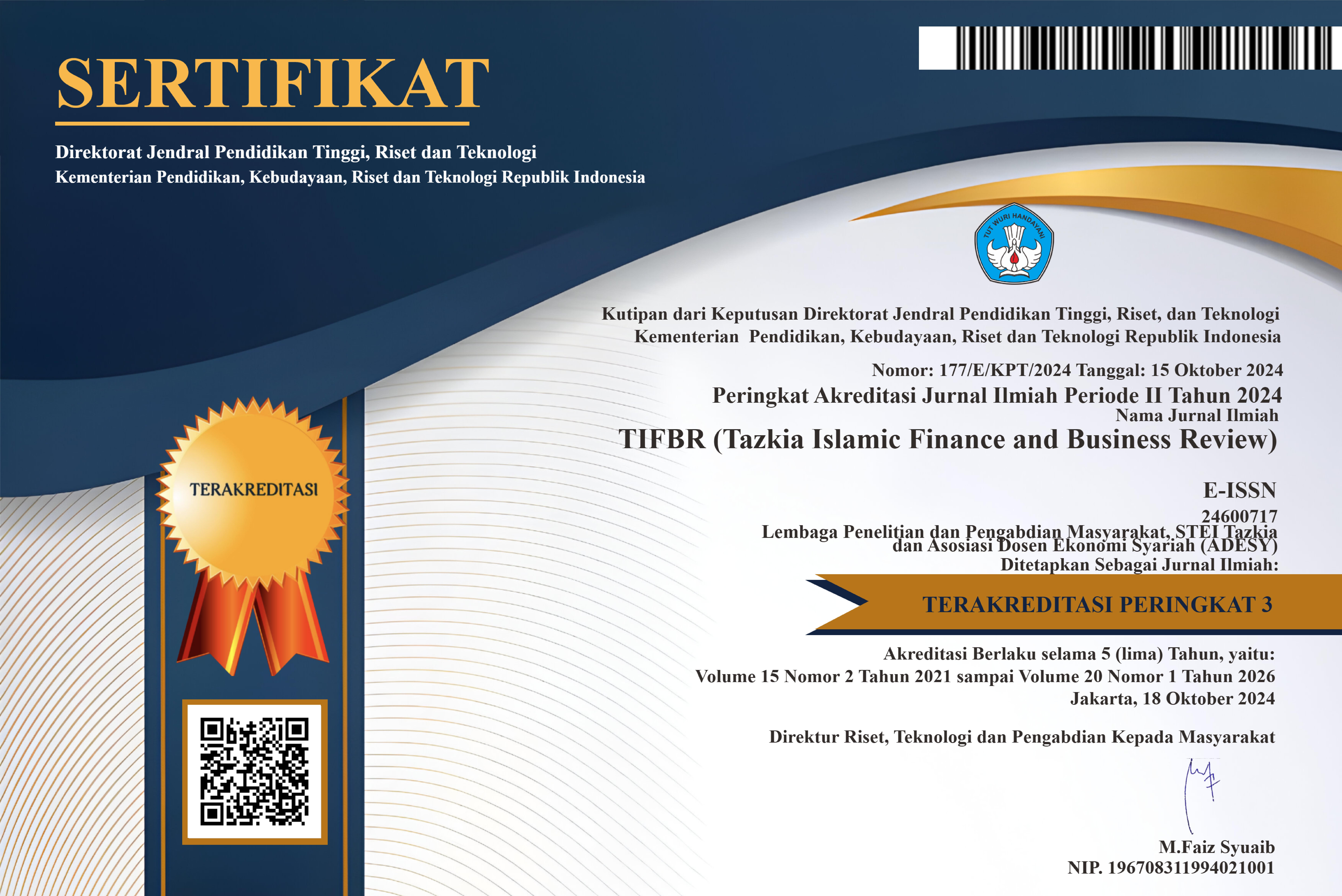Macroeconomic Determinants of Islamic Banking Financing
DOI:
https://doi.org/10.30993/tifbr.v11i2.136Kata Kunci:
Islamic banking financing, macroeconomc variables, VAR/VECMAbstrak
The purpose of this study is to analyze the relationship between Islamic banking financing and macroeconomic variables as well as its response to key economic variables including real output, price level, interest rate and trade for the case of Indonesia. This research uses time series econometric analysis such as Granger Causality and Vector Error Correction Model (VECM). Time series data used are total Islamic banking financing, industrial production index (IPI), customer price index (CPI), Certificate Bank Indonesia (SBI) rate and international trade. The results show that there is bi-directional relationship between Islamic banking financing and price level as well as Islamic banking financing and interest rate. Meanwhile, the uni directional causality occurs between Islamic banking financing and real output as well as Islamic banking financing and trade. In this case, Islamic banking financing is affected by IPI. Islamic banking financing is not affected by trade but trade is significantly affected by Islamic banking financing. In addition, Islamic banking financing is relatively sensitive to the shock of price level, real output and interest rate.Referensi
Abduh, M. and Chowdhury, N. T. (2012). Does Islamic Banking Matter for Economic Growth in Bangladesh? Journal of Islamic Economics, Banking and Finance, Vol. 8(3): 104–113.
Abduh, M. and Omar, M. A. (2012). Islamic Banking and Economic Growth : The Indonesian Experience, International Journal of Islamic and Middle Eastern Finance and Management, Vol. 5(1): 35–47.
Abduh, M. Omar, M. A. and Duasa, J. (2011). The Impact of Crisis and Macroeconomic Variables towards Islamic Banking Deposits Department of Business Administration Department of Economics, Kulliyah of Economics and Management Sciences , International Islamic University , Malaysia. Vol. 8(12): 1413–1418.
Abdul Kader, R. and Leong, Y. K. (2009). The Impact of Interest Rate Changes on Islamic Bank Financing. International Review of Business Research Papers, Vol. 5(3): 189–201.
Cham, T. (2018). Determinants of Islamic Banking Growth: An Empirical Analysis. International Journal of Islamic and Middle Eastern Finance and Management, IMEFM-01-2017-0023.
Darrat, A. . (2002). The Relative Efficiency of Interest-Free Monetary System: Some Empirical Evidence. Quarterly Review of Economics and Finance, Vol. 42: 747–764.
Enders, W. (1995). Applied Econometrics Time Series. Canada: John Wiley and Sons, inc.
Firdaus, M. (2011). Aplikasi Ekonometrika untuk Data Panel dan Time Series. Bogor: IPB Press.
Furqani, H. M. R. (2009). Islamic Banking and Economic Growth: Empirical Evidence from Malaysia. Journal of Economic Cooperation and Development, Vol. 30(2): 59–74.
Gujarati. (2003). Ekonometrika Dasar. Jakarta: Erlangga.
Gujarati. (2004). Basics Econometrics, Fourth Edition (Fourth Edi). New York: The McGraw Hill Companies.
Hachicha, N. A. A. Ben. (2015). Does Islamic Bank Financing Contribute to Economic Growth? The Malaysian Case. International Journal of Islamic and Middle Eastern Finance and Management Management, Vol. 8(3): 349–368.
Ibrahim, M. and Sufian, F. (2014). A Structural VAR Analysis of Islamic Financing in Malaysia. Studies in Economics and Finance, Vol. 31(4): 371–386.
Ibrahim, M. H. and Sukmana, R. (2011). Dynamics of Islamic Financing in Malaysia: Causality and Innovation Accounting. Journal of Asia-Pacific Business, 12(1), 4–19.
IFSB. (2013). Islamic Financial Services Industry Stability Report 2013.
IFSB. (2017). ISLAMIC FINANCIAL SERVICES INDUSTRY STABILITY REPORT 2017.
Karim, B. A. et al. (2012). The Impact of Subprime Mortgage Crisis on Islamic Banking and Islamic Stock Market. Procedia - Social and Behavioral Sciences, Vol. 65: 668–673.
Kasri, R. A. and Kassim, S. H. (2009). Empirical Determinants of Saving in the Islamic Banks: Evidence from Indonesia. Journal of King Abdulaziz University, Islamic Economics, Vol. 22(2): 181–201.
Kassim, S. and Majid, M. S. (2010). Impact of Financial Shocks on Islamic Banks Malaysian Evidence During 1997 and 2007 Financial Crises. International Journal of Islamic and Middle Eastern Finance and Management, Vol. 3(4): 291–305.
Kassim, S. (2016). Islamic Finance and Economic Growth: The Malaysian Experience. Global Finance Journal, Vol. 30: 66–76.
Kia, A. (2001). Interest-Free and Interest-Bearing Money Demand: Policy Invariance and Stability. Atlanda.
Meera, A.K.M. and Larbani, M. (2006). Part I: Seigniorage of Fiat Money and The Maqasid Al-Shari’ah: The Unattainableness of The Maqasid. Humanomics, Vol. 22(1): 17–33.
Mohd. Yusof, R. and Bahlous, M. (2013). Islamic Banking and Economic Growth in GCC Andamp; East Asia Countries. Journal of Islamic Accounting and Business Research, Vol. 4(2): 151–172.
Mohd Yusof, R., et al. (2018). Macroeconomic Shocks, Fragility and Home Financing in Malaysia: Can Rental Index be The Answer? Journal of Islamic Accounting and Business Research, Vol. 9(1): 17–44.
Muthohharoh, M. (2010). Analisis Dampak Guncangan Makroekonomi terhadap Stabilitas Perbankan dalam Sistem Perbankan Ganda di Indonesia. Bogor Agricultural University.
Nursechafia. (2010). Pengaruh Guncangan Variabel Makroekonomi terhadap Dana Pihak Ketiga dan Kredit Perbankan pada Sistem Perbankan Ganda di Indonesia. Bogor Agricultural University.
OJK. (2017). Statistik Perbankan Syariah.
Rizky, M., Sakti, P., and Thas, M. (2018). The Concept and Practices of Macroprudential Policy in Indonesia : Islamic and Conventional, 10(January): 75–96.
Samad, A. (2004). The Performance of Malaysian Islamic Bank during 1984-1997: An Exploratory Study. IIUM Journal of Economics and Management, Vol. 12(2): 115–129.
Wei, W. (2006). Time Series Analysis: Univariate and Multivariate Methods. California: Pearson Education, Inc.
Abduh, M. and Omar, M. A. (2012). Islamic Banking and Economic Growth : The Indonesian Experience, International Journal of Islamic and Middle Eastern Finance and Management, Vol. 5(1): 35–47.
Abduh, M. Omar, M. A. and Duasa, J. (2011). The Impact of Crisis and Macroeconomic Variables towards Islamic Banking Deposits Department of Business Administration Department of Economics, Kulliyah of Economics and Management Sciences , International Islamic University , Malaysia. Vol. 8(12): 1413–1418.
Abdul Kader, R. and Leong, Y. K. (2009). The Impact of Interest Rate Changes on Islamic Bank Financing. International Review of Business Research Papers, Vol. 5(3): 189–201.
Cham, T. (2018). Determinants of Islamic Banking Growth: An Empirical Analysis. International Journal of Islamic and Middle Eastern Finance and Management, IMEFM-01-2017-0023.
Darrat, A. . (2002). The Relative Efficiency of Interest-Free Monetary System: Some Empirical Evidence. Quarterly Review of Economics and Finance, Vol. 42: 747–764.
Enders, W. (1995). Applied Econometrics Time Series. Canada: John Wiley and Sons, inc.
Firdaus, M. (2011). Aplikasi Ekonometrika untuk Data Panel dan Time Series. Bogor: IPB Press.
Furqani, H. M. R. (2009). Islamic Banking and Economic Growth: Empirical Evidence from Malaysia. Journal of Economic Cooperation and Development, Vol. 30(2): 59–74.
Gujarati. (2003). Ekonometrika Dasar. Jakarta: Erlangga.
Gujarati. (2004). Basics Econometrics, Fourth Edition (Fourth Edi). New York: The McGraw Hill Companies.
Hachicha, N. A. A. Ben. (2015). Does Islamic Bank Financing Contribute to Economic Growth? The Malaysian Case. International Journal of Islamic and Middle Eastern Finance and Management Management, Vol. 8(3): 349–368.
Ibrahim, M. and Sufian, F. (2014). A Structural VAR Analysis of Islamic Financing in Malaysia. Studies in Economics and Finance, Vol. 31(4): 371–386.
Ibrahim, M. H. and Sukmana, R. (2011). Dynamics of Islamic Financing in Malaysia: Causality and Innovation Accounting. Journal of Asia-Pacific Business, 12(1), 4–19.
IFSB. (2013). Islamic Financial Services Industry Stability Report 2013.
IFSB. (2017). ISLAMIC FINANCIAL SERVICES INDUSTRY STABILITY REPORT 2017.
Karim, B. A. et al. (2012). The Impact of Subprime Mortgage Crisis on Islamic Banking and Islamic Stock Market. Procedia - Social and Behavioral Sciences, Vol. 65: 668–673.
Kasri, R. A. and Kassim, S. H. (2009). Empirical Determinants of Saving in the Islamic Banks: Evidence from Indonesia. Journal of King Abdulaziz University, Islamic Economics, Vol. 22(2): 181–201.
Kassim, S. and Majid, M. S. (2010). Impact of Financial Shocks on Islamic Banks Malaysian Evidence During 1997 and 2007 Financial Crises. International Journal of Islamic and Middle Eastern Finance and Management, Vol. 3(4): 291–305.
Kassim, S. (2016). Islamic Finance and Economic Growth: The Malaysian Experience. Global Finance Journal, Vol. 30: 66–76.
Kia, A. (2001). Interest-Free and Interest-Bearing Money Demand: Policy Invariance and Stability. Atlanda.
Meera, A.K.M. and Larbani, M. (2006). Part I: Seigniorage of Fiat Money and The Maqasid Al-Shari’ah: The Unattainableness of The Maqasid. Humanomics, Vol. 22(1): 17–33.
Mohd. Yusof, R. and Bahlous, M. (2013). Islamic Banking and Economic Growth in GCC Andamp; East Asia Countries. Journal of Islamic Accounting and Business Research, Vol. 4(2): 151–172.
Mohd Yusof, R., et al. (2018). Macroeconomic Shocks, Fragility and Home Financing in Malaysia: Can Rental Index be The Answer? Journal of Islamic Accounting and Business Research, Vol. 9(1): 17–44.
Muthohharoh, M. (2010). Analisis Dampak Guncangan Makroekonomi terhadap Stabilitas Perbankan dalam Sistem Perbankan Ganda di Indonesia. Bogor Agricultural University.
Nursechafia. (2010). Pengaruh Guncangan Variabel Makroekonomi terhadap Dana Pihak Ketiga dan Kredit Perbankan pada Sistem Perbankan Ganda di Indonesia. Bogor Agricultural University.
OJK. (2017). Statistik Perbankan Syariah.
Rizky, M., Sakti, P., and Thas, M. (2018). The Concept and Practices of Macroprudential Policy in Indonesia : Islamic and Conventional, 10(January): 75–96.
Samad, A. (2004). The Performance of Malaysian Islamic Bank during 1984-1997: An Exploratory Study. IIUM Journal of Economics and Management, Vol. 12(2): 115–129.
Wei, W. (2006). Time Series Analysis: Univariate and Multivariate Methods. California: Pearson Education, Inc.
##submission.downloads##
Diterbitkan
2018-06-05
Cara Mengutip
Nursyamsiah, T. (2018). Macroeconomic Determinants of Islamic Banking Financing. Tazkia Islamic Finance and Business Review, 11(2). https://doi.org/10.30993/tifbr.v11i2.136
Terbitan
Bagian
Articles
Lisensi

Tazkia Islamic Finance and Business Review (TIFBR) is licensed under a Creative Commons Attribution-NonCommercial 4.0 International License.
Authors who publish with this journal agree to the following terms:
- Authors retain copyright and grant the journal right of first publication with the work simultaneously licensed under a Creative Commons Attribution License that allows others to share the work with an acknowledgment of the work's authorship and initial publication in this journal.
- Authors are able to enter into separate, additional contractual arrangements for the non-exclusive distribution of the journal's published version of the work (e.g., post it to an institutional repository or publish it in a book), with an acknowledgment of its initial publication in this journal.
- Authors are permitted and encouraged to post their work online (e.g., in institutional repositories or on their website), as it can lead to productive exchanges, as well as earlier and greater citation of published work (See the Effect of Open Access).
















